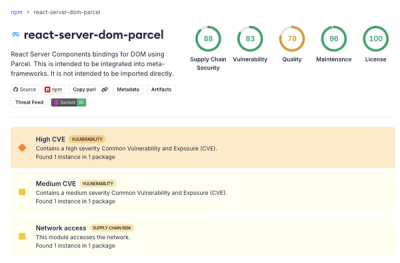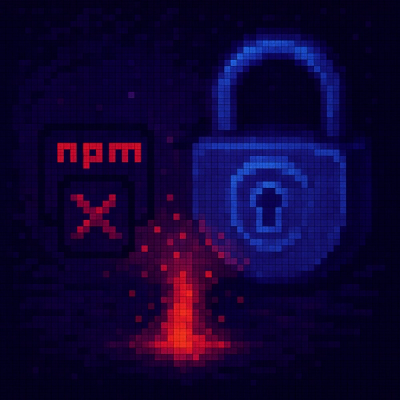
Security News
New React Server Components Vulnerabilities: DoS and Source Code Exposure
New DoS and source code exposure bugs in React Server Components and Next.js: what’s affected and how to update safely.
tbxforms
Advanced tools
A Torchbox-flavoured template pack for django-crispy-forms, adapted from crispy-forms-gds
A Torchbox-flavoured template pack for django-crispy-forms, adapted from crispy-forms-gds.
Out of the box, forms created with tbxforms will look like the
GOV.UK Design System, though many
variables can be customised.
>=3.8.1,<4.0>=3.2>=2.1,<3.0>=2.15 if using WagtailBaseForm>=1.33.0 if building the sass yourself[!NOTE] govuk-frontend will not, and does not need to, be installed to use this package.
All form-related styles from
govuk-frontend==5.4.1have been copied into this project with the prepended "govuk-" replaced with "tbxforms-", e.g..govuk-buttonto.tbxforms-buttonand@mixin govuk-clearfixto@mixin tbxforms-clearfix.
For non-government projects, installing the complete GOV.UK Frontend package unnecessarily increases the bundle size as we only need form-related styles.
For government projects, this increases the bundle size as both tbxforms and
govuk-frontend must be installed. However, these projects are less common, so
they are not prioritised.
You must install both the Python package and the NPM package.
Install using pip:
pip install tbxforms
Add django-crispy-forms and tbxforms to your installed apps:
INSTALLED_APPS = [
# ...
'crispy_forms', # django-crispy-forms
'tbxforms',
]
Now add the following settings to tell django-crispy-forms to use tbxforms:
CRISPY_ALLOWED_TEMPLATE_PACKS = ["tbxforms"]
CRISPY_TEMPLATE_PACK = "tbxforms"
Install using NPM:
npm install tbxforms
Note: This package uses the Element.closest, NodeList.forEach, and
Array.includes APIs. You will need to install and configure polyfills for
legacy browser support if you need to.
Instantiate your forms:
import TbxForms from 'tbxforms';
document.addEventListener('DOMContentLoaded', () => {
for (const form of document.querySelectorAll(TbxForms.selector())) {
new TbxForms(form);
}
});
Import the styles into your project...
...Either as CSS without any customisations:
@use 'node_modules/tbxforms/dist/style.css';
...Or as Sass to customise variables:
@use 'node_modules/tbxforms/tbxforms.scss' with (
$tbxforms-text-colour: #000,
$tbxforms-error-colour: #f00,
);
tbxforms provides out-of-the-box GOV.UK Design System styles for everything
except buttons, as styles for these probably exist within your project.
You will need to write button styles for the following classes:
.tbxforms-button.tbxforms-button.tbxforms-button--primary.tbxforms-button.tbxforms-button--secondary.tbxforms-button.tbxforms-button--warningtbxforms can be used for coded Django forms and editor-controlled Wagtail forms.
All forms must inherit the TbxFormsMixin mixin, as well as specifying a Django base form class (e.g. forms.Form or forms.ModelForm)
from django import forms
from tbxforms.forms import TbxFormsMixin
class ExampleForm(TbxFormsMixin, forms.Form):
...
class ExampleModelForm(TbxFormsMixin, forms.ModelForm):
...
Wagtail forms must inherit from TbxFormsMixin and WagtailBaseForm.
from wagtail.contrib.forms.forms import BaseForm as WagtailBaseForm
from tbxforms.forms import TbxFormsMixin
class ExampleWagtailForm(TbxFormsMixin, WagtailBaseForm):
...
In your form definitions (e.g. forms.py):
from tbxforms.forms import BaseWagtailFormBuilder as TbxFormsBaseWagtailFormBuilder
from path.to.your.forms import ExampleWagtailForm
class WagtailFormBuilder(TbxFormsBaseWagtailFormBuilder):
def get_form_class(self):
return type(str("WagtailForm"), (ExampleWagtailForm,), self.formfields)
And in your form page models (e.g. models.py):
from path.to.your.forms import WagtailFormBuilder
class ExampleFormPage(...):
...
form_builder = WagtailFormBuilder
...
Just like Django Crispy Forms, you need to pass your form object to the
{% crispy ... %} template tag, e.g.:
{% load crispy_forms_tags %}
<html>
<body>
{% crispy your_sexy_form %}
</body>
</html>
FormHelpersA FormHelper allows you to alter the rendering behaviour of forms.
Every form that inherits from TbxFormsMixin (i.e. every form within tbxforms)
will have a FormHelper with the following default attributes:
highlight_required_fields: see later section on highlighting required fieldshtml5_required = Truelabel_size = Size.MEDIUMlegend_size = Size.MEDIUMform_error_title = _("There is a problem with your submission")These can be changed during instantiation or on the go - examples below.
Submit buttons are not automatically added to forms. To add one, you can extend
the form.helper.layout (examples below).
Extend during instantiation:
from django import forms
from tbxforms.forms import TbxFormsMixin
from tbxforms.layout import Button
class YourSexyForm(TbxFormsMixin, forms.Form):
def __init__(self, *args, **kwargs):
super().__init__(*args, **kwargs)
self.helper.layout.extend([
Button.primary(
name="submit",
type="submit",
value="Submit",
)
])
Or afterwards:
from tbxforms.layout import Button
form = YourSexyForm()
form.helper.layout.extend([
Button.primary(
name="submit",
type="submit",
value="Submit",
)
])
tbxforms can show/hide parts of the layout depending on a given value. For
example, you could show an email address field only when the user
chooses to sign up to a newsletter (examples below).
You can apply this logic to field, div, and fieldset elements.
Field example:
from django import forms
from django.core.exceptions import ValidationError
from tbxforms.choices import Choice
from tbxforms.forms import TbxFormsMixin
from tbxforms.layout import Field, Layout
class ExampleForm(TbxFormsMixin, forms.Form):
NEWSLETTER_CHOICES = (
Choice("yes", "Yes please", hint="Receive occasional email newsletters."),
Choice("no", "No thanks"),
)
newsletter_signup = forms.ChoiceField(
choices=NEWSLETTER_CHOICES
)
email = forms.EmailField(
widget=forms.EmailInput(required=False)
)
def __init__(self, *args, **kwargs):
super().__init__(*args, **kwargs)
self.helper.layout = Layout(
# Add our newsletter sign-up field.
Field.text("newsletter_signup"),
# Add our email field and define the conditional logic.
Field.text(
"email",
data_conditional={
"field_name": "newsletter_signup", # Field to inspect.
"values": ["yes"], # Value(s) to cause this field to show.
},
),
)
Container example:
When you have multiple fields/elements that you want to show/hide together, you
can use the exact same data_conditional definition as above but on a div or
fieldset element, e.g.:
from tbxforms.layout import HTML, Div, Field, Layout
Layout(
Div(
HTML("<p>Some relevant text.</p>"),
Field.text("some_other_field"),
Field.text("email"),
data_conditional={
"field_name": "newsletter_signup",
"values": ["yes"],
},
),
)
Conditional fields must be optional (required=False) as they are not always
visible, but it can be useful to show them as required to the user.
To do this, use the conditional_fields_to_show_as_required() method:
from django import forms
from django.core.exceptions import ValidationError
from tbxforms.choices import Choice
from tbxforms.forms import TbxFormsMixin
from tbxforms.layout import Field, Layout
class ExampleForm(TbxFormsMixin, forms.Form):
NEWSLETTER_CHOICES = (
Choice("yes", "Yes please", hint="Receive occasional email newsletters."),
Choice("no", "No thanks"),
)
newsletter_signup = forms.ChoiceField(
choices=NEWSLETTER_CHOICES
)
email = forms.EmailField(
widget=forms.EmailInput(required=False)
)
def __init__(self, *args, **kwargs):
super().__init__(*args, **kwargs)
self.helper.layout = Layout(
# Add our newsletter sign-up field.
Field.text("newsletter_signup"),
# Add our email field and define the conditional logic.
Field.text(
"email",
data_conditional={
"field_name": "newsletter_signup", # Field to inspect.
"values": ["yes"], # Value(s) to cause this field to show.
},
),
)
@staticmethod
def conditional_fields_to_show_as_required() -> [str]:
# Non-required fields that should show as required to the user.
return [
"email",
]
def clean(self):
cleaned_data = super().clean()
newsletter_signup = cleaned_data.get("newsletter_signup")
email = cleaned_data.get("email")
# Fields included within `conditional_fields_to_show_as_required()` will
# be shown as required but not marked as required. Therefore, we need to
# write our own check to enforce the value exists.
if newsletter_signup == "yes" and not email:
raise ValidationError(
{
"email": "This field is required.",
}
)
return cleaned_data
If TBXFORMS_HIGHLIGHT_REQUIRED_FIELDS=False (or unset), optional fields will
have "(optional)" appended to their labels. This is the default behaviour and
recommended by GDS.
If TBXFORMS_HIGHLIGHT_REQUIRED_FIELDS=True, required fields will have an
asterisk appended to their labels and optional fields will not be highlighted.
This setting can be changed on a per-form basis by setting the form helper's
highlight_required_fields attribute:
from django import forms
from tbxforms.forms import TbxFormsMixin
class ExampleForm(TbxFormsMixin, forms.Form):
def __init__(self, *args, **kwargs):
super().__init__(*args, **kwargs)
# Highlight required fields regardless of settings.TBXFORMS_HIGHLIGHT_REQUIRED_FIELDS
self.helper.highlight_required_fields = True
You can also style these markers by targeting these CSS classes:
.tbxforms-field_marker--required.tbxforms-field_marker--optionalLabel and legend sizes can be changed through the form's helper, e.g.:
from tbxforms.layout import Size
class ExampleForm(...):
...
def __init__(self, *args, **kwargs):
super().__init__(*args, **kwargs)
self.helper.label_size = Size.LARGE
self.helper.legend_size = Size.LARGE
Possible values for the label_size and legend_size:
SMALLMEDIUM (default)LARGEEXTRA_LARGEYou can disable the error summary
by setting show_error_summary=False in the form's helper, e.g.:
class ExampleForm(...):
...
def __init__(self, *args, **kwargs):
super().__init__(*args, **kwargs)
self.helper.show_error_summary = False
This is useful if your form has a complex setup and you need complete control over the error summary - e.g. if the form also contains a formset. In this instance, you would want to create your own error summary template and include it in your template.
FAQs
A Torchbox-flavoured template pack for django-crispy-forms, adapted from crispy-forms-gds
We found that tbxforms demonstrated a healthy version release cadence and project activity because the last version was released less than a year ago. It has 1 open source maintainer collaborating on the project.
Did you know?

Socket for GitHub automatically highlights issues in each pull request and monitors the health of all your open source dependencies. Discover the contents of your packages and block harmful activity before you install or update your dependencies.

Security News
New DoS and source code exposure bugs in React Server Components and Next.js: what’s affected and how to update safely.

Security News
Socket CEO Feross Aboukhadijeh joins Software Engineering Daily to discuss modern software supply chain attacks and rising AI-driven security risks.

Security News
GitHub has revoked npm classic tokens for publishing; maintainers must migrate, but OpenJS warns OIDC trusted publishing still has risky gaps for critical projects.